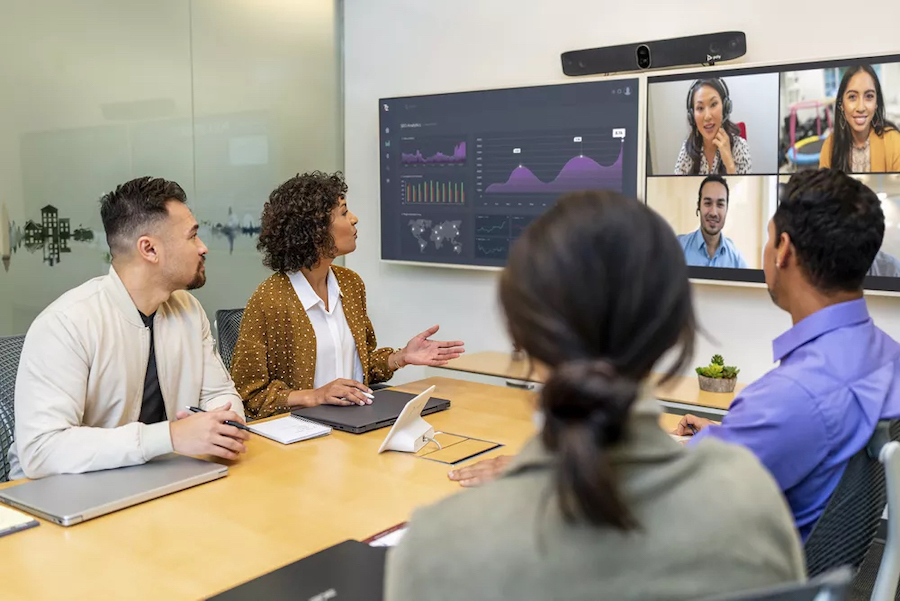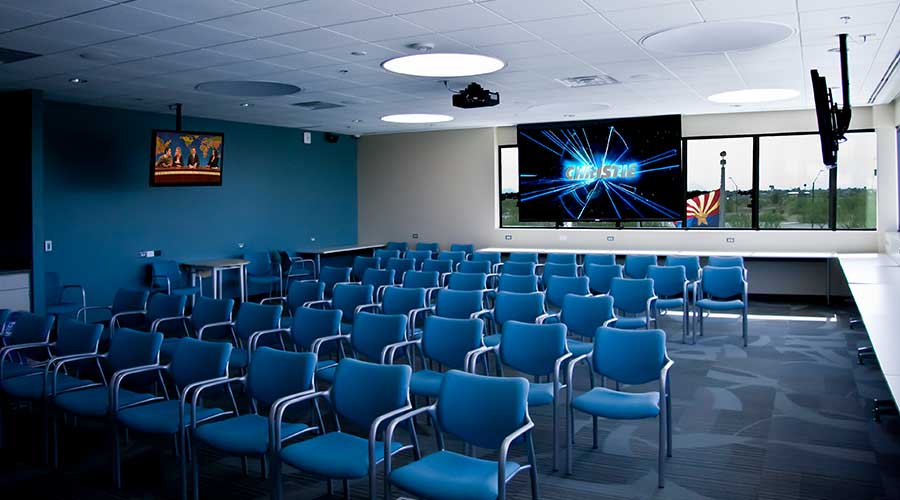Now more than ever before, companies and organizations must continually consider how they can improve communications within their teams. As such, it is no surprise that topics like meeting equity have only increased in their relevance. Despite that, many working professionals still don't have a firm grasp on what meeting equity is and how improving it can benefit just about any organization. For those not yet in the know, this article will give you a quick introduction to what meeting equity is and how to improve it.
on Monday, 16 October 2023.
Posted in Audio-Visual Systems, AV as a Service, Meeting Room Solutions
For companies in the private sector, updated technology is critical to beating competitors and increasing revenue, so many businesses build their budgets to prioritize AV and IT spending. For public sector organizations, however, updating technology is not so simple. An incremental, year-to-year budgeting process can make large capital investments in technology difficult. And, because government agencies are not profit—or competition—driven, big tech investments can be difficult to justify. However, updated technology and the way it improves business processes, delivery and customer satisfaction should be just as important to the public sector as it is to the private sector. Here are five reasons government agencies and organizations should update their technology.
on Thursday, 08 June 2023.
Posted in Audio-Visual Systems
Poly Meeting Room Solutions Support the Most Advanced Features for Hybrid Work
Do you know the old saying about the best-laid plans? You can plan for every contingency or occurrence, but inevitably something happens that you didn't imagine and throws a huge wrench in your intricate plan. So while planning is necessary, a great strategy can adapt to the unforeseen. So what does all this have to do with meeting room solutions?
The internet is breathless with all the discussion around hybrid work, and we've also postulated plenty about the subject on these pages. But as we all know, the future of hybrid work is uncertain. How many people will return to offices? What will be the mix of remote versus in-office staff? Most companies are wading through that right now, with many mandating some minimum days in the office while others adopt a remote-first approach. How, then, do you plan your meeting room technology investments? The best way is to invest in adaptable solutions, ready for anything the future holds.
As everyone knows, two of the leading platforms enabling and advancing hybrid work are Microsoft Teams and Zoom. And much of the upgrades to meeting room technology in the past 2-3 years have involved integrating these platforms into meeting spaces seamlessly. Some of the most flexible solutions for this come from Poly, a well-known and longtime brand in meeting room technology. They offer built-in Teams and Zoom Room functionality, so you don't have to choose. And significantly, they leverage the latest features of these platforms to give your teams a collaborative edge.
The point is, whether you have two people in your meeting room versus eight people the next day, your meeting room AV makes each meeting just as productive, no matter where all the participants are. Let's explore some of these key features below.
on Wednesday, 15 March 2023.
Posted in Meeting Room Solutions, Phoenix, AZ, Meeting Room Solutions
Poly Offers Standardized Solutions with the Latest Technology
In the not-too-distant past, setting up a video conferencing room was an exercise in integration. Separate cameras, microphones, speakers, processing, interconnects, and control interfaces all had to be integrated into a cohesive system. Many conference rooms are still custom-built this way, depending on the specific needs of that space and the organization. However, there has been a rise in the “appliance” meeting room solution, an integrated solution that solves the audio and video communication needs of most conference rooms.
Some of the best of those solutions come from Poly, a longtime player in conference room AV, starting with the ubiquitous Polycom conferencing phones from the 1980s that were found in most corporate meeting rooms. Now, you might think, does an appliance-type solution work for the enterprise? One of the things that aids in deploying meeting room solutions across hundreds or thousands of rooms in disparate locations is standardization. If you can operate a solution in each space that is consistent in usage and operation, you decrease complexity, downtime, and cost. Aided by the fact that Poly is now part of HP and has worldwide distribution and support, solutions like the Poly Studio appliance series are a smart choice for enterprises in Phoenix, AZ, and around the world.
Keep reading below to explore the benefits of Poly meeting room solutions for your organization.
on Tuesday, 28 February 2023.
Posted in Meeting Room Solutions, Phoenix, AZ, Meeting Room Solutions
4 Major Benefits of Integration as a Service
As technology continues to advance rapidly, businesses may find themselves replacing their AV systems every few years to keep up with modern demands—or be stuck with outdated solutions. If only there were a simpler way to update and expand…
There is—the “as-a-service” model applied to technology integration. Integration as a Service works like a subscription plan in which your provider integrates disparate systems and technologies, providing them as a working, on-demand service to your organization. IaaS includes systems monitoring and maintaining the infrastructure for you.
And just like phone plans allow customers to upgrade their smartphones every few years, IaaS is a convenient, simple way to outsource AV management. So rather than pay one time for an integration installation, you’ll pay a monthly subscription for much less of a hassle.
Here’s why Integration as a Service is worthwhile for your business.
on Monday, 20 February 2023.
Posted in Integration as a Service
AV Is a Service to Your Organization
As a term, service delivery management seems self-explanatory. If you’re in the information technology world, you also understand how it applies to your sphere of influence. In the AV world, let’s say that considering your AV infrastructure – like conference rooms and meeting spaces – as a service might not seem intuitive, but it is. Your AV investments are not a collection of rooms, microphones, projectors, screens, cameras, and audio mixers; they are a service to facilitate communication and collaboration for your organization.
How, then, do you apply principles of service delivery management best practices to your AV systems? If you’ve adopted the mindset that AV is a service, you're halfway there. We can take many of the same techniques applied to IT services to AV and adapt them accordingly. Let's take a closer look at five essential practices and metrics to ensure your Tempe, AZ, organization can properly evaluate the quality of service delivery management.
on Monday, 13 February 2023.
Posted in Service Delivery Management Tempe, AZ, Service Delivery Management
DELIVER BETTER EXPERIENCES WITH UPDATED GOVERNMENT AV TECHNOLOGY
The old adage “Close enough for government work” is a cheeky way to justify results that almost hit the mark. But when it comes to audiovisual technology solutions, many government agencies don’t come close to having the capabilities they need. That can end up costing governments—and citizens—a lot of money. For example, the Government Accountability Office recently reported that the federal government’s 10 legacy technology systems most in need of modernization cost taxpayers $337 million a year to operate and maintain, while newer systems are must less expensive to manage. The catch is, updating outdated AV is also an expensive proposition, and government agencies and organizations may struggle to find the necessary funding in their year-to-year-budgeting cycle. However, strategic updates to government AV can improve processes and create better experiences for citizens, making government organizations and entities more effective in the long run. Keep reading for insights into the best ways to update your government AV technology.
on Monday, 13 February 2023.
Posted in Audio-Visual Systems
Make Sure Your Managed IT Solutions Covers These Bases
If your organization hires a third party for managed AV, you’ll want to ensure you’re getting the best service possible. So what does that look like?
With more IoT devices than ever in our conference rooms and offices, these cloud-connected gadgets are as vulnerable to cyber threats as any computer or laptop. You need an IT management company that consistently updates your network and ensures all endpoints are protected.
A great managed AV provider should work with your existing network processes rather than bulldoze through with their own standards. They should be transparent and proactively update your network. Before partnering with a company for managed IT solutions, make sure they provide an SLA with detailed metrics and look for the following six features.
on Monday, 06 February 2023.
Posted in Managed IT Solutions, Scottsdale, AZ, Managed IT Solutions
 Meeting Equity: What Is It And How To Improve
Meeting Equity: What Is It And How To Improve 







